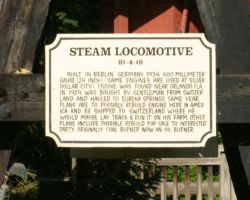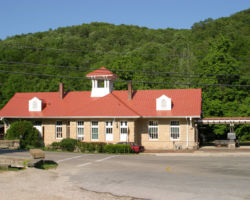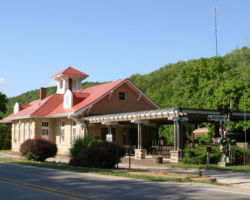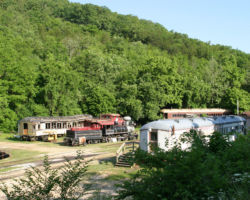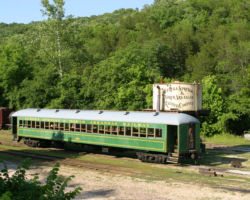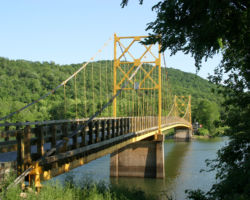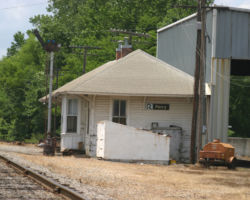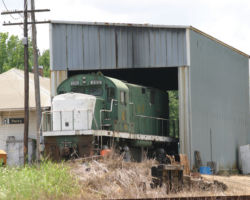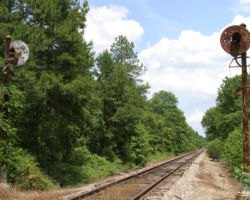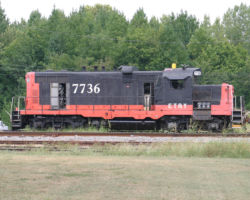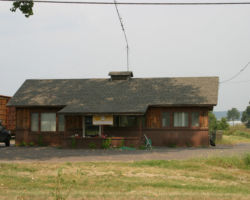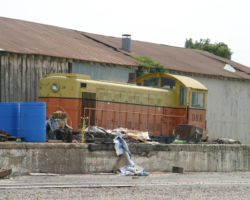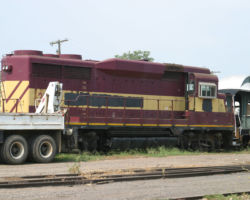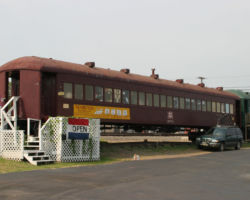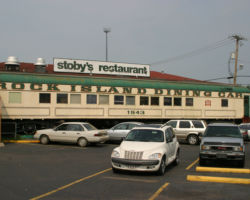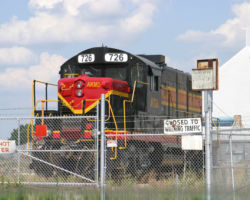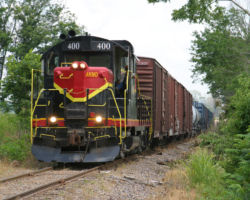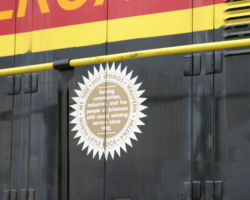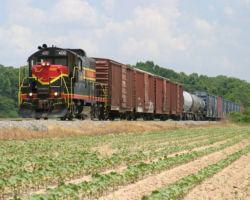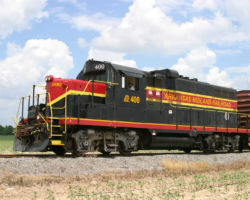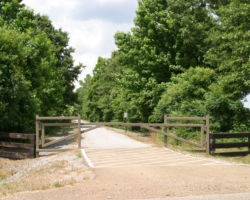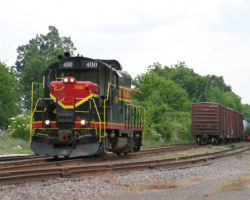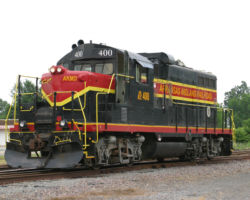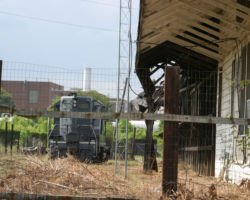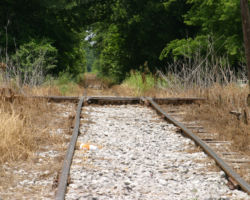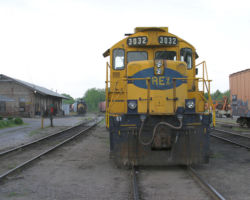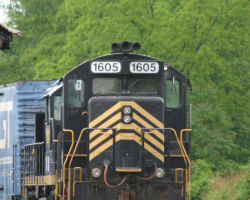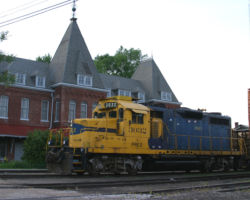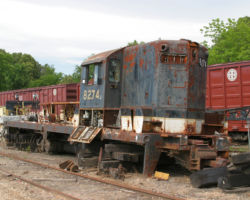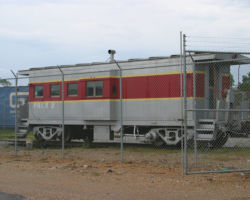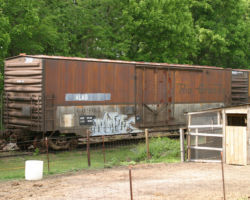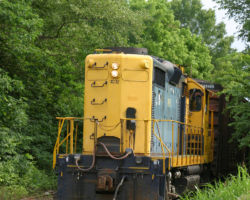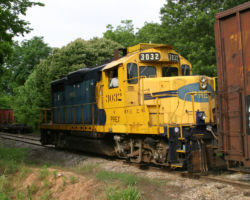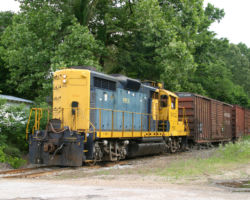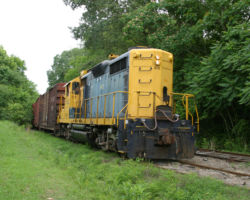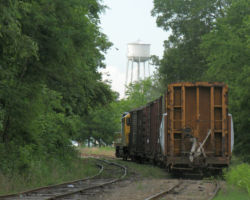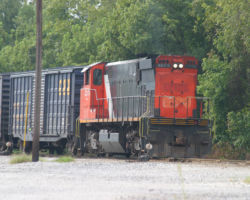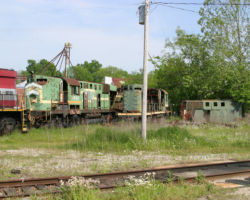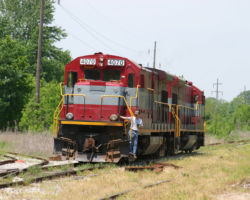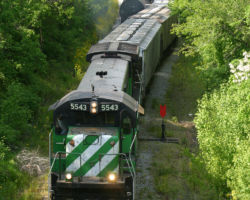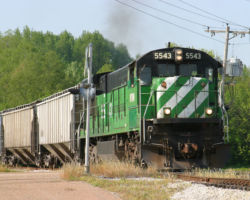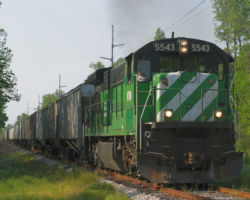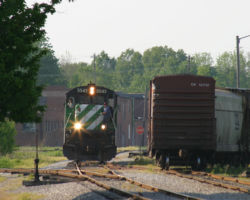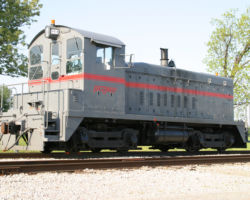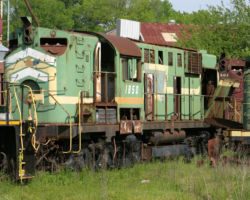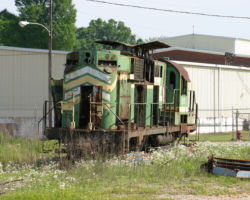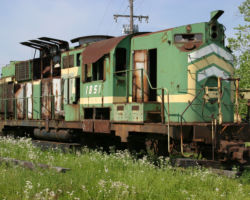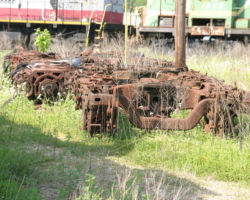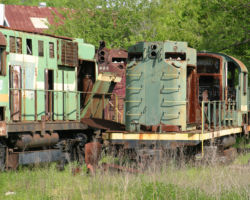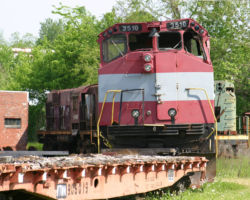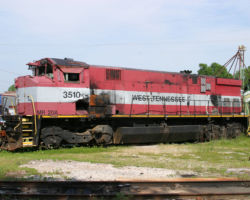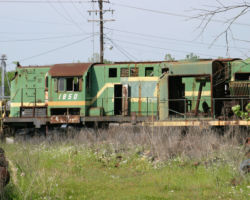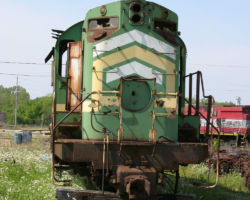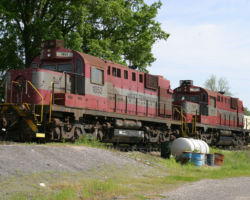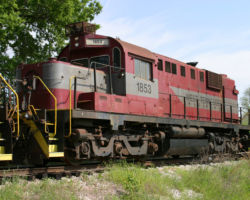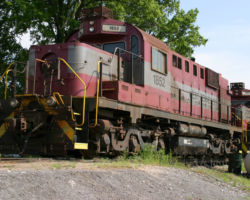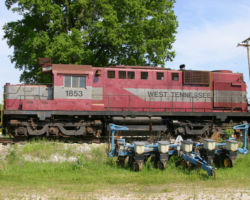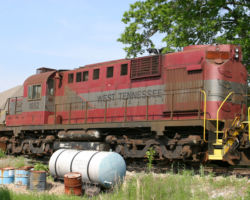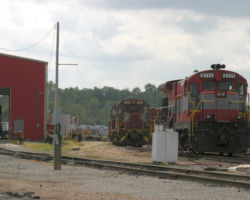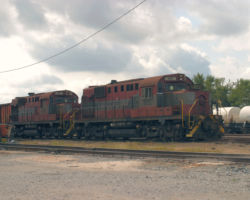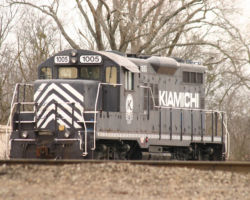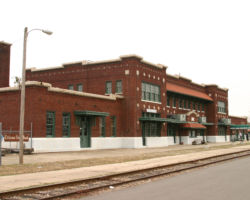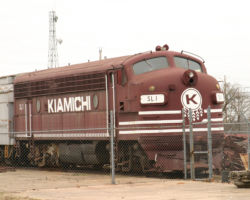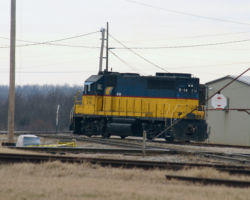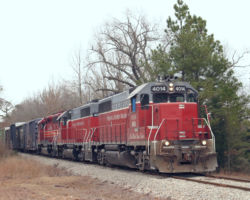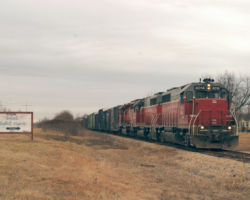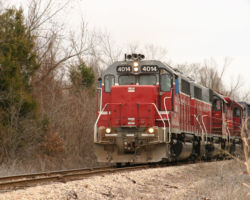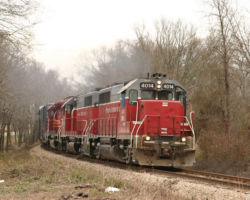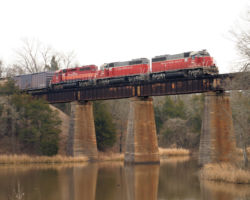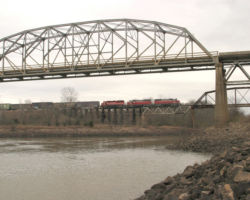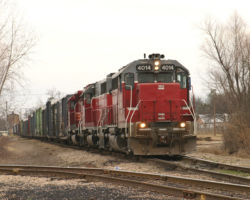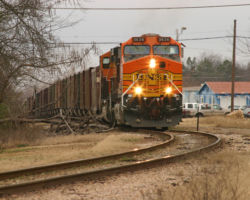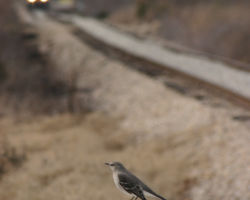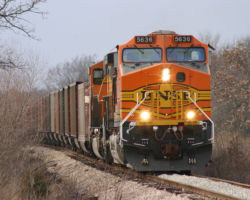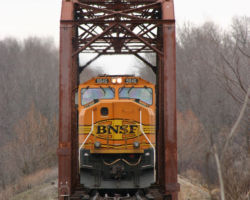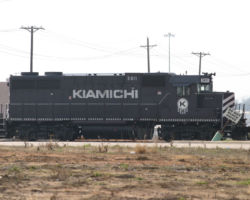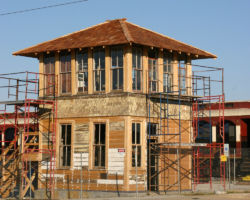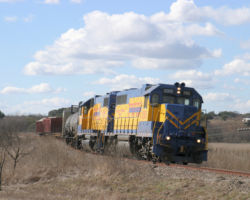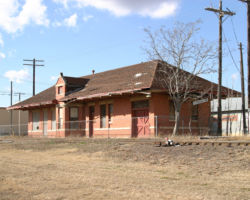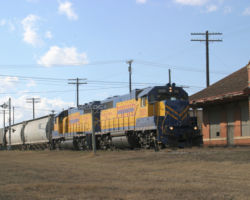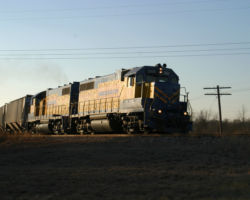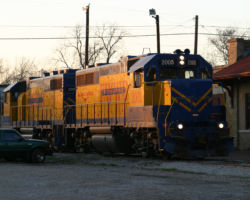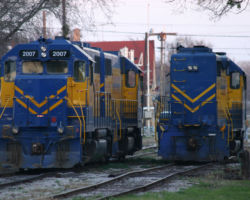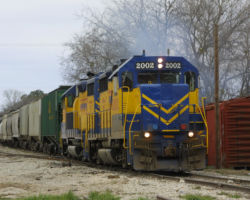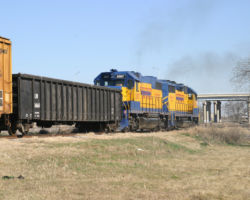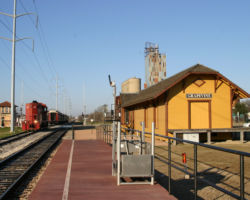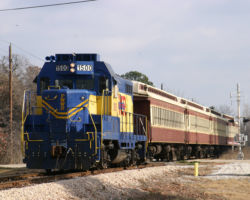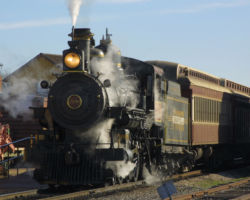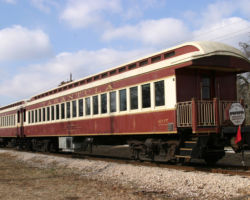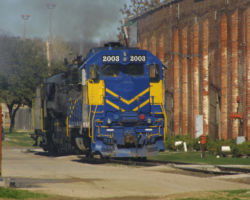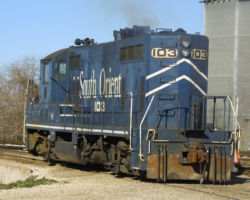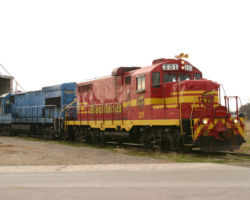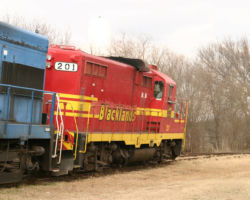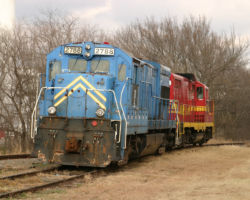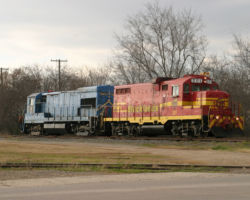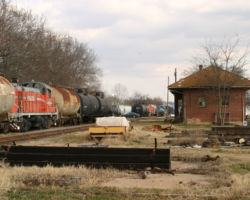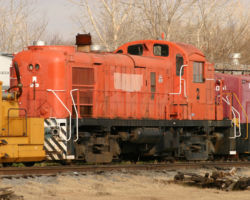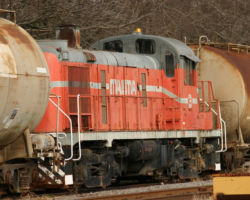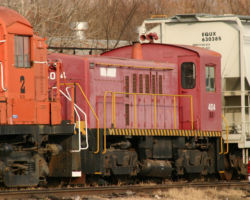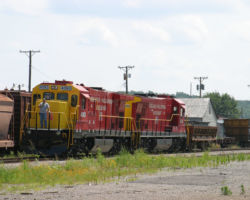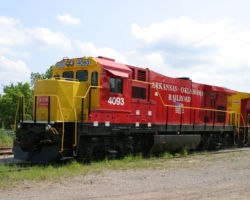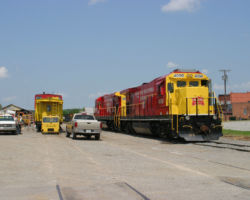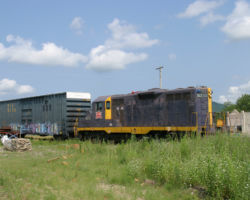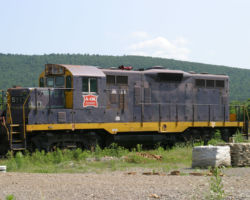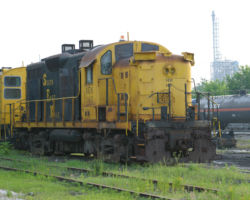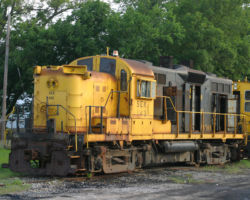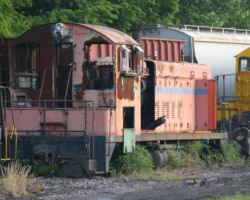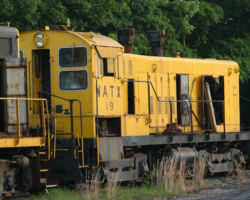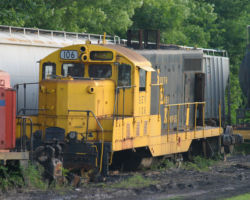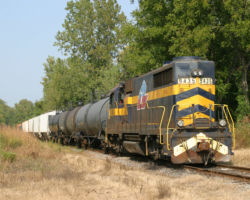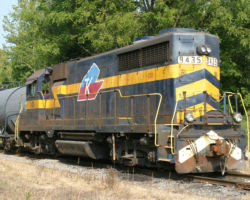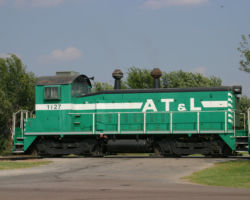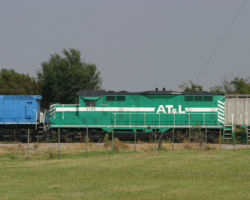The Eureka Springs & North Arkansas – Jun 5, 2005
Eureka Springs & North Arkansas was originally built in 1882 as the Eureka Springs Railway, which joined the small town with the Frisco mainline at Seligman, MO (which, incidentally is the Arkansas & Missouri mainline today, covered in previous chapters). In later years, the railroad grew much, much larger. Under the name Missouri & North Arkansas (the original, not the RailAmerica regional that exists today) and later just Missouri & Arkansas, the line eventually spanned from Joplin, MO, clear across the state of Arkansas to Helena, AR. Due to labor problems in the 1940s, by 1949 most of the route had been abandoned except for the Seligman, MO, to Harrison, AR, segment, as well as the short Eureka Springs branch. These segments reorganized as the Arkansas & Ozarks Railroad, which survived until flooding severely damaged the line in 1960. By 1962, all of the former ESR/M&NA/M&A/A&O rails were pulled. (Thanks to the North Arkansas Line website for the quick history lesson.)
Today’s Eureka Springs & North Arkansas was reconstructed on about 4.5 miles of the original route between Eureka Springs and the former junction with the lines to Seligman and Harrison near Gaskins, AR. The route was rebuilt sometime in the 1980s, though, and today tourists ride the route. Power is an EMD SW-1, ESNA 4742, which was in January of 1942 for the Chicago & Eastern Illinois as their #98. Behind it are a number of vintage coaches. The trip runs out of the historic Eureka Springs depot – a beautiful old cut stone building. Also, out behind the building are a number of historic bits – old railcars, at least one interesting steamer, a turntable, etc. Unfortunately, I arrived late on a Saturday evening, so I wasn’t able to ride or even photograph the train moving. One of these days I’ll get back there… For those wanting to see the line, take Highway 187 out the north end of Eureka Springs and the depot is impossible to miss.
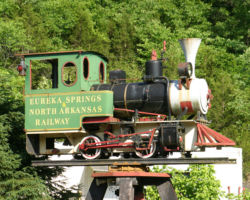
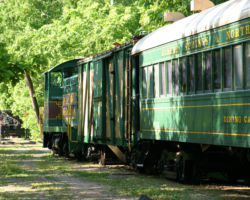
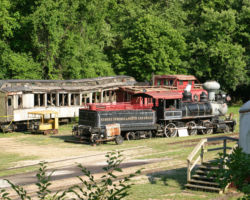
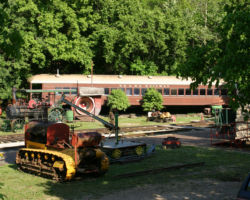
The Little Rock & Western – Jun 6, 2005
Our next shortline is the Little Rock and Western. The LRWN is moderately-sized shortline of about 79 miles operating between North Little Rock, AR, on the east and Danville, AR, on the west. The track is part of the Rock Island’s once-mighty Choctaw Route, which spanned from Tucumcari, NM, to Memphis, TN, while the Rock was operating. After the bankruptcy and liquidation of the CRI&P, much of the line was taken up. The LRWN started with just the 44 miles from North Little Rock to near Perry in order to serve the Arkansas Kraft Division of Green Bay Packaging. In 1986, they also acquired a lease on the 35 miles from Perry to Danville to serve Continental Grain Company’s Wayne Farms facility. Today, they operate the line using two C-420s, LRWN 101 and 102, along with GP8 7736. Operations are based out of Perry, AR, and you can pick them up on the radio on 160.965 MHz (main road channel) and 160.245 (Perry repeater input).
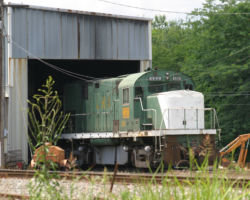
The Dardanelle & Russellville Railroad – Sep 12, 2005
Moving on, no discussion of south-central shortlines would be complete without the Dardanelle & Russellville, which is positively ancient as far as shortlines go. The 4.8 mile route from the UP’s former Missouri Pacific main at Russellville, AR, to the Arkansas River terminal at North Dardanelle, AR, has been in continuous shortline service since 1883, and was organized as the current company in 1900. They operate a small fleet of EMD and Alco switchers (EMD SW-1s, Alco S-1s, and an EMD GMD-1) over the line. Several sit out at the customer plant sites, and as such are very inaccessible. I don’t have a radio frequency for them, but the very short line is easily followed from Russellville southwards. The main office and small yard is located under the Arkansas Hwy 27 river bridge between Dardanelle and North Dardanelle. (As a point of interest, the D&R’s SW-1 #16 was built as Chicago & Eastern Illinois #99 and is the sister unit of ESNA 4742 above, which started as C&EI #98.)
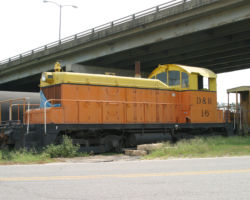
Arkansas Midland Railroad – Jun 10, 2005
The Arkansas Midland Railroad, was founded in 1992 to take over operations on about 112 miles of Union Pacific branches in Arkansas. It consists of four disconnected lines: 1) Helena to Lexa, AR 2) a short stretch from North Little Rock to Galloway 3) Malvern to Mountain Pine, AR, and 4) McGehee to Warren, AR. On the way over from the A&M to Memphis, I stopped and wandered around North Little Rock a bit to find AKMD 726 all penned up in chain link. (Photo #90) Oh well, it wasn’t the greatest part of NLR, it probably needed the fence. Then again, I’m not sure there is a good part of North Little Rock…
Since I was working nights in Memphis, I had all day to do whatever I wanted, pending work didn’t urgently need anything. On Friday, 10-Jun-2005, I decided to go check out two lines southwest of Memphis – the AKMD’s Helena-Lexa line and the Mississippi Delta (MSDR) lines running out of Clarksdale, MS. Since the AKMD was closer, I decided to pop across the river and have a look at it first. While driving along on US 49, I saw a string of boxcars along the line. I figured that, like many shortlines, those were probably parked there generating fees and didn’t think anything of it. Then I looked again, and there were less cars visible than there before! The realization finally sank in that yes, this was a train – just a really slow moving one. So, I shot down to the nearest grade crossing ahead of it and set up. A few minutes later, AKMD 400 came bobbing and weaving down the light track with seventeen cars in tow – 14 boxcars and 3 tankers. (Photos #91-92) Honestly, it was one of the few times that there was so much bobbing and weaving that I really took a few steps away before it hit the grade crossing. This was really light track!
Following US 49 west, you’ll come to a road going north about 4-5 miles west of West Helena. It should be labelled Phillips Road 251 or some such. Anyway, it’ll take you back up to the tracks through some farm fields. I found the fiends made a very nice foreground for another shot of 400, this time on better, freshly ballasted track. (Photo #93) I’ve always wanted to go visit the AKMD, since the paint reminds me of a strangely Iowa Interstate-esque paint scheme. (Photo #94) Following the road on around, you cross over what used to be the line south out of Lexa. Part of the line between McGehee, AR, and Tallulah, AR, still exists as the Delta Southern, but the Lexa-McGehee segment is abandoned. However, to the north of Lexa, the line is still owned by UP and serves as the AKMD’s connection to the outside world.
There wasn’t much more for 400 and crew to do. Once reaching Lexa, they cut off the train in a small yard (Photo #96) and brought the engine up to the Arkansas Hwy 242 grade crossing (the only one in town). This is near the railroad’s local office, and with the day’s work done and a severe thunderstorm approaching from the west, 400 got tied down in a small stub track (Photo #97).
With no more AKMD action for the day and a thunderstorm pounding away at Arkansas, I retreated back across the river and headed on south towards Clarksdale, MS. My goal was to have a look at the MSDR, the Mississippi Delta Railway.
Mississippi Delta Railroad – Jun 10, 2005
the Mississippi Delta Railway. The road consists of a set of ex-IC branch trackage sold in 1985 to what I believe was the Gulf & Ohio railroad. The lines extend from the IC/CN interchange at Swan Lake, MS, north to Clarksdale and then on up to Lula, where another connecting branch cuts back down to Jonestown. The history is more than a little confusing, but the whole thing was put up for abandonment during July of 2001. Some time after that point, Coahoma County, where the line primarily operates, purchased the trackage, explaining why it’s still there. It now appears to be being operated under contract, but I believe is still doing business as the Mississippi Delta Railroad.
Most of the line is in pretty bad shape, particularly north of Clarksdale. One of my favorites is the nasty-looking diamond at Lula, MS. (Photo #98) From Lula over to Jonestown, I’d rate the line as nearly impassible, but south of Lula didn’t look too bad (some newer ballast indicating semi-recent improvements, some stored cars). I never found any sign of movement, but I did find the road’s motive power. The offices are in a falling-down building in Clarksdale on the south leg of the old wye, just north of 4th Street (421 4th Street, to be exact). The power is GP9 6226, believed to be an ex-C&O unit of the same number. (Photo #99) For anyone wishing to fan the line (good luck catching it running), the radio frequency looks to be 160.500 MHz.
Not wanting the trip back to be a total waste, I followed the IC/CN mainline back to Memphis in order to photograph something I should have caught back in 2003 – the coaling tower at Lambert. A dinosaur from the age of steam, one has to wonder why this relic is still standing. Regardless, there it is, in all of its grandeur, still waiting to fuel some steamer that will never come.
Mississippi Central Railroad – Jun 8, 2005
Probably the closest shortline to Memphis, the Mississippi Central (MSCI) operates the line from Grand Junction, TN, to Oxford, MS. Now relegated to shortline status and largely abandoned, this route was once one of the oldest and most important lines in the state. The route was originally chartered as the (original) Mississippi Central in 1852, with the charter of linking Canton, MS, where it connected with the New Orleans, Jackson, & Great Northern, with Grand Junction, TN, where it joined the Memphis and Charleston. This gave them a continuous rail connection all the way down to the Gulf of Mexico. Interestingly enough, as with many southern railroads before the Civil War, the line was built with a gauge of 5 feet – 3.5 inches greater than standard gauge, and incompatible with the northern rail network. Sometime before the Civil War, the line was extended from Grand Junction north another fifty or so miles to Jackson, TN. At Jackson, it met the Mobile & Ohio, which ran up to a point on the Mississippi River immediately below Cairo, the then-terminus of the Illinois Central.
In 1861, the nation plunged into Civil War, with Mississippi breaking off to join the Confederacy. The Mississippi Central would play a significant part in this conflict. On 2-Nov-1862, General Ulysses Grant’s army would start at Grand Junction, TN, and follow the Mississippi Central southward, capturing it as a supply line from the Union for his advancing troops. About two weeks later, his 37,000 troops lay seige to Holly Springs, MS, and establishing it as a base of operations for their march south to Vickburg. The confederates succeeded only a month later in wrecking the junction at Jackson and destroying significant portions of the Mississippi Central, effectively taking it out of play for the Union. By mid-1864, it was back in Confederate hands and serving as a supply line to southern Tennessee, and again destroyed, but this time by the Union.
With peace and the union restored by 1866, the Illinois Central was looking for ways to connect itself with the ports of the Gulf Coast. They realized that the future lay in bridging the industry of Chicago with ports on the coast. In 1872, the IC purchased the Mississippi Central and the New Orleans, Jackson, & Great Northern. However, the Mobile & Ohio, which hereto had provided the northern connection out of Jackson to the Mississippi River, was a competitor of the IC. Thus, a new line was in order from Jackson, and by late 1873, a new route was complete from Jackson to across the river from Cairo. By ferrying freight across the Mississippi River at Cairo, the Illinois Central could achieve nearly a continuous rail connection between Chicago and the Gulf of Mexico. Ferrying freight is not very effective, and definitely not a cost effective way to run a railroad. Something else was in order.
Realizing that eventually the lines would connect all the way through, the IC had the entire 550 miles of southern 5′ gauge system converted to standard gauge on 29-Jul-1881. The conversion of the main took 9 hours and 30,000 laborers, but it was indeed complete in a single day. At the end of that decade, the IC completed the Cairo Bridge, a four mile long steel structure spanning the Ohio River. This finally linked the southern half of the system to the northern half without the car ferry in the middle.
The line’s position in the limelight would not last, however. It had a fundamental flaw – it bypassed the important river town of Memphis. By 1893, the IC would acquire the Chesapeake, Ohio, & Southwestern. Despite its name, it included a line that linked Memphis to Granada, the CO&S’s interchange with the ex-MC line. By the middle of the next decade, the IC started routing most of its passenger traffic away from the MC and over onto the Memphis route. By 1941, passenger service disappeared from the route. By 1982, as part of ICG’s great system rationalization, the line was abandoned south of Oxford as far as Bruce Junction (a few miles north of Granada) and north of Grand Junction as far as Jackson. The section between Granada and Bruce Junction is still operated by the IC/CN to interchange with the Mississippi & Skuna Valley. Most of the rest went up for sale as a shortline.
What was left of the Mississippi Central between Grand Junction and Oxford was sold to Kyle Railways on 1-Mar-1982 and operated as the Natchez Trace Railway. This went on for about a decade. Then, on 1-Apr-1992, Pioneer Railcorp bought out Kyle Railways’ interest in the NTR and, on 12-Jan-1993, officially changed its name to the Mississippi Central Railroad. The line continues today under this banner.
Today’s operations are based at the Holly Springs, MS, yard, and are run on an as-needed basis. Power usually seems to be PREX GP20 3032, an ex-ATSF unit. (Photo #100, from May 2003) However, MSCI 1604 and 1605 (Photo #101, from 2003) seem to be used occasionally. These two units, rebuilt from GP9s and classed as GP16s, are both in the classy Pioneer black-and-yellow scheme with Mississippi Central on the side. They move around, so they must be used, but I’ve never seen either 4 or 5 powered up. Track speed is low, since the track is not in the greatest of shape. Also, the units do not have ditch lights for running both directions, which limits their speed. If I remember correctly, their radio frequency is 160.380MHz, and they’re often quite chatty while out on the line. At least when I’ve seen them, an employee in a truck runs along ahead of the train (on the road), checking grade crossings and bridges as needed. (I had a pretty good chat with the gentleman doing this in June, since we both had plenty of time to kill at each crossing. The MSCI guys all seem to be fairly friendly folk.) As with most low-density lines, the real trick to the MSCI is actually catching them out and running.
On my way back from checking out the Mississippi & Skuna Valley, I stopped by the Holly Springs depot and yard. The depot itself is an enormous, grandious structure built in 1865 to replace the one that the Union army burned to the ground. It had a restaurant, twenty one luxury sleeping accomodations, and much more, and it is still an interesting sight, as historic and imposing as many of the other historic buildings in Holly Springs. You can see part of it in the background of Photo #102 (also from 2-May-2003). The yard is easily accessible by public road, and contains a number of interesting railroad relics. Most notable is Southern 8274. This GP7 worked on the original Natchez Trace Railway and was sold to Pioneer when they took over the line. Now, though, it’s little more than a cannibalized hulk in the backlot. (Photo #103) The back lot also has things like PREX 2, an odd but nicely painted bay window caboose that always sits in this fenced-off area. In what must just be someone’s sense of humor, there’s also PREX 97, an enormous Jordan spreader. When was the last time they had that kind of snow to deal with?
I caught them mostly by accident. I’d actually followed the line up from Oxford, hoping to catch a train on or near the magnificent Tallahatchie River bridge. No luck there, but my Holly Springs stop revealed that PREX 3032 was not in the yard. Since the line is often far from the road between Oxford and Holly Springs, there was always the chance I’d missed them somewhere, but I figured I’d take the slow road back to Memphis just in case. Turns out, my suspicion was correct.
Just north of Holly Springs, I started picking up chatter on the radio. Nothing really intelligable, but I could tell it wasn’t BNSF or NS-type chatter like I’d expect to hear. So, I checked the first public grade crossing I knew of at Hudsonville. I looked right as I went to cross the rails, and I saw a boxcar rear. It didn’t appear to be moving, so I assumed they were now using the main for car storage for some reason. I went a little further, whipped the car around at a wide spot in the road, and went back over the crossing. Tada – no boxcar! Huh?
So, I drove up to the next available point – the crossing at Lamar. Lamar is a the only town of significance between Holly Springs and Grand Junction, and the MSCI has a small siding in town loaded with old, odd cars. Back in 2003, there was an old Rio Grande aspen gold and silver boxcar (ex-DRGW 60903) sitting there. (Photo #105) When I got to the grade crossing, I noticed a truck pull up that I’d met coming down the road from Hudsonville. I didn’t really think much of it (another fan?) until I noticed that the guy’s lips were moving in sync to the words coming out of my scanner. Ah, an employee! Since he realized that I was listening to him, I went over and said hello. We got to talking about a lot of stuff – the MSCI, my trip to Memphis, how he came to work out here, cars, all sorts of stuff. He was kind enough to tell me that they’d be going up to Grand Junction and tying for the night, and then go back in the morning to fetch the interchanged cars from the NS. Shortly thereafter, 3032 showed up (Photo #106) with four cars in two – three boxcars and a bulkhead flat with two giant tarped objects on it. Since this was the first MSCI train I’d ever seen moving, the chase (if you can call following a 10-15 mph train that) was on, and it was even going my way!
It’s hard to get a variety of shots on the MSCI’s north end. For the most part, the railroad runs away from the highway through swampy land, and where you can access it, it’s travelling down a narrow green canyon. As an example, we see 3032 heading out of Lamar and back into the tree chasm (Photo #107). So, really the choice of shots at the next crossing, up at Michigan City, wasn’t all that much better. (Photo #108)
At Grand Junction, the plan was to drop the cars so that an NS job could get them overnight and drop new cars for the MSCI. The power would then drag these cars back to Holly Springs early the next morning. 3032 and crew slowly brought the 3032 up into town (Photo #109), first having to stop at the south end of the siding and clear a small tree that had fallen over and fouled the main. Once they did that, they brought the cars in on the main, tied them down (Photo #110), and moved the power off (I think onto the siding) so that the NS job could just come down and pull the cars. Since the action was over, I called it a day with the MSCI at that point and headed back to Memphis to catch some sleep before working that night.
West Tennessee Railroad – Sep 2005
Another of Western Tennesee’s more famous shortlines is, appropriately enough, the West Tennessee Railroad. The WTNN was founded in 1984 to operate the ICG’s Kenton branch, then scheduled to be abandoned. The road, based at Jackson, now operates about 180 miles of line radiating in five different directions out of Jackson:
- Short stubs both east, west, and south of Jackson, TN – The east and west stubs are part of the former L&N / NC&St.L main into Memphis. The stub going south may be part of the old Mississippi Central, but I’m not positive on this, since two routes originally went south from Jackson.
- North to Fulton, KY – This line is former Illinois Central and is, in fact, the connector built by the IC in 1873 to connect the Mississippi Central (discussed in Chapter 8) with Cairo, IL. The route was most recently owned by the NS and leased to the WTNN on 1-Aug-2001.
- North to Kenton, TN – This is the former GM&O main that descended from the Mobile & Ohio route to Columbus, KY. This was the original northern interchange route for the Mississippi Central before the IC acquisition. Today the line stubs out at Kenton, TN.
- South from Jackson to Corinth, MS – The ex-GM&O Okolona Disrict, this line originally connected all the way through to Birmingham, AL. More recently, it was owned by the NS and basically stopped at Corinth, MS, where it connected with the NS’s east-west main to Memphis. On 1-Aug-2001, the WTNN leased the entire Corinth-Fulton route.
The hub of all WTNN operations is the ex-GM&O Iselin Yard in Jackson. Last I knew, about four jobs operate on the weekdays. The first comes on at 0700h to work the Fulton line. On M-W-F, it works all the way up to the IC/CN interchange at Fulton, whereas on T-Th it only goes partway up the line. At 0800h, two more jobs start – one to work the old line up towards Kenton, and the other to do local work in the yard and on the shorter stubs radiating from Jackson. The NS interchange job down to Corinth supposedly comes on about 2000h and works overnight, making it difficult or impossible to photograph, except in the very longest days of the year. (Thanks to Mike Derrick and other sources, mostly from Trainorders, for the operational information.) Be sure to listen to the FRED frequency and the WTNN’s radio channels, which I show as 160.245 MHz, 161.070 MHz, and 161.475 MHz.
Iselin was a relatively minor yard on the GM&O, but with a significant locomotive maintenance facility. This mammoth brick and glass structure still stands today, though to my knowledge no one uses it. The modern WTNN uses a small pole building adjacent to the main yard tracks for today’s locomotive work. At this site, they maintain a fleet of GEs and MLWs. Until recently, the road still ran a rare fleet of Alcos – ex-LS&I RSD12 units. However, these have all been retired and many scrapped. (You’ll get to see many of them in the all-photo chaper 10m resting at their final graveyard in Trenton, TN. These rare beauties are no longer there, and presumably have all been cut up except for the RSD12s 1801 and 1802, which now sit dead at Iselin.) Today’s power is a gaggle of ex-CSXT and ex-Conrail B23-7s and a pair of ex-BN C30-7s, along with one or two MLW M420Ws. The B23s and C30s usually handle the road jobs, whereas every time I’ve seen one of the M420s working, it’s moving cars around in the yard. (Photo #111)
The first time I went out after the WTNN was on 28-Apr-2003. Not having up to date information about the Fulton-Corinth lines and wanting to see the deadlines in Trenton, I picked the Kenton line as a place to start. However, on the way out of town, I picked up radio chatter around Jackson. Having no idea what I was doing, I started running around town until I finally found a pair of headlights on the line heading west out of town. It turned out to be a pair of B23-7s in the WTNN’s red and silver paint returning from switching a customer. In the lead was WTNN 4070, followed by WTNN 4081. I photographed them (Photo #112) as they stopped to back down another customer siding, and then went on north to look for one of the road trains.
Since I had no idea if there was even a train out on this line, I stopped by the Trenton depot to check out the dead lines. (Photo #113) Stored here in mid-2003 were WTNN 1852 and 1853 – low nose RSD12s from the Lake Superior & Ishpeming and originally purchased by the B&O. These two units were operational, but only used as backups at the time. Today, they’re stored at Iselin and, as I’ve heard, pretty much red-tagged by the FRA for the rest of their life. However, it wasn’t what ran in Iselin that was as interesting as the stuff that would never run again. Behind the depot, on an old set of yard tracks (or just sitting on blocks in the field) were a four high-nose RSD12s and an M420W. The dead units were: (don’t worry, there are photos of all of them in Chapter 10)
- WTNN 1801, in solid L&SI green but with no prime mover, generator, long hood, or trucks
- WTNN/LSI 1803 in solid burgundy and missing its fuel tank
- WTNN/LSI 1850, still in full green with yellow/white stripes and mostly complete
- WTNN/LSI 1851, still in full green with yellow/white stripes but without trucks
- WTNN 3510 in full WTNN paint, but with sideswipe and fire damage
I didn’t get much until I started picking up radio chatter at Dyer, TN, about six miles from the end of the line, I started picking up radio chatter again. The old road through Dyer crosses the railway on a small bridge just south of downtown. As I passed overhead, I looked down to see the headlights of WTNN 5543, one of the ex-BN C30-7 units, looking back. The crew was switching the grain elevator at Dyer, and looked to be putting their train back together. I stopped in the parking lot of the nearby convenience store and walked out for a shot from the (narrow) bridge (Photo #114). With the train getting underway, it was back in the car and south to look for the next shot.
This is that point at which everything goes wrong. South of Dyer there is a school. Just as I was headed out, the school buses had begun their launch. I got stuck behind not only a line of big rolling yellow obstructions, but specifically the one serving stops along the road we were on. Passing was either unsafe while moving or illegal while not, so I just resigned myself to move at the speed of AAAARGGGGGHHHH! Meanwhile, 5537 was steadily rolling southward towards Trenton… ahead of me.
Once we got down a way, the offending bus turned off onto a side road and I was able to kick back up to speed limit (or maybe a little over) for the trip into Trenton. I’d gotten the shot set up in my head, as conveniently there was a small road on the west side of the tracks approaching the depot. Not a second after I was out of the car, I noticed two things – the crossing bells on Hwy 104 were starting to ring, and the car was still moving forward with one of my feet inside. Oops, forgot to put the thing in park before I let off the brake… After remedying the potential runaway rental, I managed to swing myself back around, camera in hand, and almost gracefully grab photo #115. As an afterthought, I figured I’d take 116 as well – a view of today’s train passing the two operable RSD12s.
From Trenton, I followed them down as far as to Humboldt, stopping about halfway in between for Photo #117. It’s not the greatest, but like many smaller railroads in Tennessee, the WTNN is encased in trees for much of its run. Humboldt was to be the end of the run for today. This is where the WTNN interchanges with CSXT’s line, and the crew dropped a cut of cars to be handed over. After watching them switch for a while (Photo #118) and then mention tying down on the radio, I decided to call it a day. I needed to get back to Memphis in decent time anyway in order to catch some sleep before the night shift.
I followed CSXT back into Memphis, but I didn’t see a darn thing moving. The only thing interesting was the Pictsweet switcher located in Bells, TN.
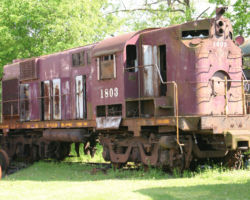
The Kiamichi Railroad – Feb 2004
The Kiamichi Railroad is quite possibly one of the least covered (at least by fans) regionals in the US, considering its size of 227 track miles. In its nearly twenty years of existance, I only know of a single railfan article on the road having been published – Trains Magazine, September 1989. Part of this is certainly explained by its location. The KRR is in deep, rural southern Oklahoma and western Arkansas, near only a few major transportation corridors.
The Kiamichi began life on 22-Jul-1987 with two cast-off Frisco bits purchased from the Burlington Northern. The short segment, running from just north of Antlers, OK, to just south of Paris, TX, is a hunk out of the old Frisco Central Division mainline. This is the same route that the Arkansas & Missouri’s mainline was carved from around the same time. However, by the time the A&M and KRR were created, nearly all the track between Wister (on the ex-Rock Island Choctaw line, now the Arkansas-Oklahoma that we’ll visit later) and Antlers was abandoned rather sold to any shortline, thus severing it as a through route.
This ex-Central Division mainline crosses the old east-west Frisco Arkinda-Ardmore Subdivision at Hugo, OK. This route between Ardmore on the west and Hope, AR, on the east was built by the Arkansas & Choctaw between 1895 and 1902. It was completed by 1902 as a through route and renamed to the St. Louis, San Francisco and New Orleans Railroad – grandiose goals for a short road in the middle of nowhere. By 1907, the railroad was folded into the Frisco corporate identity. In 1982, the line was cut between Mead and Madill due to the creation of Lake Texoma, forcing the Frisco to use trackage rights to reach Madill and Ardmore. In 1982, the Ardmore-Madill segment was abandoned. Five years later, in 1987, BN sold the remaining Lakeside, OK (where the former Arkinda-Ardmore Sub joined the BN line to cross the lake) to Hope, AR, segment to the newly formed Kiamichi, along with the remaining bits of the north-south Central Division mainline.
The KRR tried to expand in 1990 with the creation of a subsidiary – the Chaparral Railroad, operating the former Santa Fe line from the KRR connection at Paris, TX, down to Farmersville, TX. Viewed as a step towards connecting with Dallas-Fort Worth and eventually the South Orient line to the Texas-Mexico border, the venture never obtained all the pieces necessary and thus never took hold. By late 1994, the Chaparral was abandoned, with the Kiamichi taking over the last significant customer just south of Paris. By the late 1990s, Statesrail had acquired the KRR, and at the beginning of 2002, Statesrail was absorbed into the giant shortline and regional operator RailAmerica. Today the signs of RA are everywhere, with the KRR’s distinctive brown and white locomotives becoming rarer, replaced with the ubiquitous grey and red motors of RailAmerica, along with visitors from other RA roads.
The hub of all things Kiamichi is Hugo, being at the crossroads of the system. Hugo contains a small yard and the road’s engine facilities, and is probably the busiest section of the road based on what I’ve heard. The road connects with the BNSF at Lakeside, OK, the UP at both Durant, OK, and Hope, AR, the TO&E (Texas, Oklahoma & Eastern) at Valliant, and the KCS at Ashdown, AR. In addition, there’s a large on-line generating station near Fort Towson that receives unit trains of coal off the BNSF Lakeside interchange, complete with run-through power. For those trying to railfan the line, be sure to monitor the Kiamichi’s four frequencies – 160.425, 160.920, 161.160, and 161.415, along with the two FRED frequencies – 452.9375 and 457.9375 MHz. FRED blips were the only indication I was getting close to a KRR train.
Having never visited the Kiamichi, I decided I’d stop by for a visit on my to Dallas in early February of 2004. I actually stayed overnight in Denison, TX, and then got up early the next morning to drive to Durant. Durant yielded a whole lot of nothing on the KRR, so off I went eastward towards the railroad’s home base at Hugo. Again, not all that much, aside from a single KRR geep sitting way in the back of the engine facility, nearly out of the sight of my camera due to obstructions. (Photo #137) Since that didn’t work out so well, I started out of town, but my eye caught on a particularly large depot still in good shape with some equipment lying around. I just had to check it out first.
In an almost Monty Python-esque bit of history (particularly the bit about swamps and castles from Holy Grail), the Frisco’s first depot was built at the crossing in Hugo in 1903. It burned to the ground in 1910, so they built another. It, too, burned to the ground in 1914. The third one was built of brick instead of wood, and it stayed up. Today, the depot is apparently renovated as the Frisco Depot Museum. (Photo #138) At one point, there was a tourist train also departing from the depot under the name Hugo Heritage Railroad, but as best I can tell, it’s defunct. There’s a small collection of railroad equipment behind the depot. One of the most notable items is an old F7A carbody, built as KCS 70A and eventually being converted to a slug by KCS. The slug then found its way to the Kiamichi and became SL1. (Photo #139) Today, it’s on static display as property of the Choctaw County Historical Society, the same group that runs the depot museum.
Having struck out again in Hugo, on east I went in hopes that somewhere on the eastern half of the system, I’d wander across a train. I was also running on limited time, since later that evening, I needed to be in the DFW area and thus couldn’t go too far out. Fortunately, fate panned out well when around Valliant I started picking up occasional radio traffic. I stalled for a few minutes, stopping to shoot TO&E D-19, which was sitting inside Weyerhaeuser’s huge pulp and paper mill. (Photo #140) Sure enough, by the time I was done, a Kiamichi was in town, though you wouldn’t know it from the looks of the power – three GP40s, none in KRR paint. The lead motor was Missouri & Northern Arkansas 4014, followed by sister M&NA 4013, and finished off with Indiana & Ohio 4031. (Photo #141) Following the line east, I managed to catch it a couple more times before reaching Fort Towsen. (Photos #142-144)
Near Fort Towsen, the line passes across two of what have to be some of the most spectacular features on the Kiamichi system. The first is a plate girder bridge over Raymond Gary Lake, literally just east of the Fort Towsen city limits. The bridge is very easily seen and photographed from US 70. (Photo #145) A few miles west at Sawyer, OK, both the railway and highway launch onto spectacular bridges that pass over the railroad’s namesake river. A few hundred yards upstream is the massive dam that impounds the Kiamichi River to create Hugo Lake. Kindly, the Corps of Engineers has created a small park and rest area on the west side, along with stairs down to the river for fishermen. This makes a very convenient place to park, walk down to the river, and grab a shot like #146.
No sooner was the inbound mixed across the Hugo diamond (Photo #147) and headed into the yard than I heard some chatter on the radio asking if the coal train was about ready to come out. Coal train? Sure, I’d seen the power plant back near Fort Towsen, but the real question was – is this an empty coming out of the plant, or a load coming over from BNSF and headed towards the plant? Fortunately there was a yard employee waiting to throw the switch for the westbound crew at the east end of the Hugo yard. I stopped and asked about the coal train, and after a few minutes of disbelief someone would drive all the way from Colorado to photograph trains in Hugo, he let me know that they were loaded and would be coming through the yard eastbound shortly.
The eastbound coal load, led by new BNSF AC4400CW 5636, appeared right on queue. Staking out a spot I’d seen earlier, I had positioned myself at the Fifth Street crossing in east Hugo. (Photo #148) It was cloudy, but there was hope – an occasional ray of sun would break through the dreary grey skies. That didn’t quite come true here until just after 5636 had passed my planned shots, though. Still, not to waste the opportunity, I jumped back in the car and shot out to the next rural grade crossing just east of the US 70 crossing. While I was waiting, I noticed a catbird sitting on a signal cabinet a few feet away. It might for one of my favorite “artsy” shots that I just found while out ‘fanning. (Photo #149) A minute or two later, the big 7FDL prime mover scared the bird, but I did get my first sunlit shot of the day. (Photo #150)
Wanting to again capture the Kiamichi River bridge but this time from a new angle, I headed down a small gravel road at the west end of the bridge. It doesn’t come out right at the bridge, but two hundred or so yards away. Fortunately, the train was DPU-equipped, and the rear unit was facing backwards, allowing for an “emerging from the bridge” shot from entirely the wrong direction of train. (Photo #151) With the plant just beyond the bridge, this would also be my last shot opportunity of the day as far as moving trains went. After that, it was down to Paris, TX, to check out the southern leg of the KRR. Not a thing was moving, but I did find another old KRR unit – GP38 3811 (Photo #152). From there, it was on into Dallas for work that night.
The Fort Worth & Western Railroad – Feb 2004
Moving along to the DFW metroplex… The Dallas/Fort Worth area has two significant shortlines of mention – the Fort Worth & Western (FWWR) and the Dallas, Garland & Northeastern (another RailAmerica line). I know very little about the DGNO, other than that one of their yards with engine facilities is located just east of I-35E and north of Belt Line Road in Carrollton, TX. I’ve been there several times and usually managed to find some interesting stuff sitting around to photograph. Other than that, it’s definitely on the list of roads I need to revisit. The other road, the FWWR, however, I have spent some time around.
The FWWR runs from essentially Carrollton, TX, down through Fort Worth to Ricker, TX, where it joins the BNSF. The FWWR uses trackage rights over the BNSF to get to San Angelo Junction, where the former South Orient line (the route FWWR uses from Ft. Worth to Ricker) once again breaks off and heads southwest towards Mexico. This section of the line southwest from San Angelo Jct. is now operated by Texas-Pacifico. In addition, there are three major branches. The first one is from Cresson to Cleburne, where it connects with the BNSF, and the other connected branch runs from Dublin out to Gorman. There is a third, disconnected branch, reached via trackage rights, from near Tower 55 down towards the Carter Industrial Park, near Everman. Their main yard and shops are located just to the west of I-35W in northern Fort Worth. Get off on exit 54B and turn north at your first opportunity. You’ll run right into the FWWR yards. For finding trains, you’ll want to tune in to 160.215 MHz and 160.785 MHz for operations around Fort Worth and 160.440 MHz for traffic down the Dublin Subdivision.
In addition to the regular FWWR freight jobs, a regular passenger train plies part of the line from Grapevine, TX, down to the Fort Worth stockyards. It was known as the Tarantula train while I was there, but now it’s apparently the Grapevine Vintage Railroad. I’ve followed the line several times and usually come up with a train. I’ve included an all-photo chapter next with coverage of the FWWR, in addition to a couple shots from the DGNO and the Blacklands Railroad.
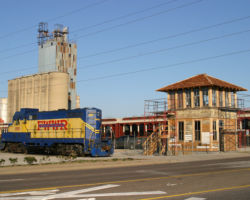
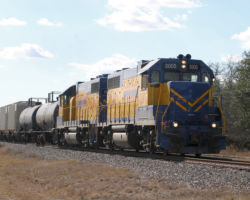
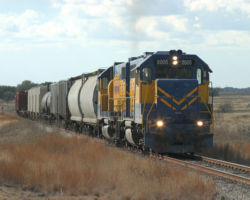
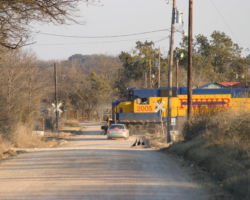
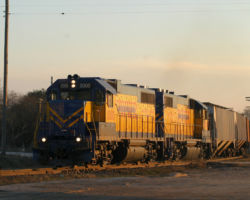
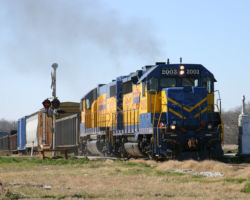
The Blacklands Railroad – Feb 2004
The Arkansas & Oklahoma Railroad
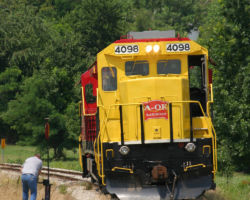
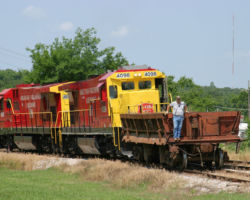
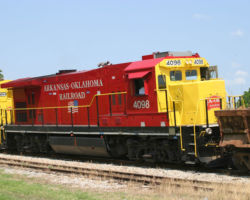
Other Miscellaneous Southern Shortlines
This is mostly stuff I didn’t have enough pictures or text to make a whole section out of, so I just lumped them together.
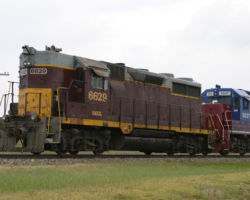
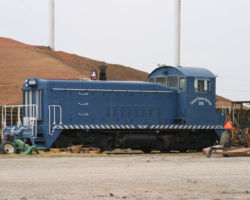
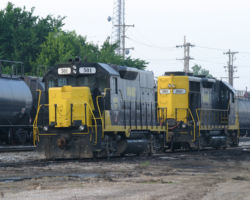
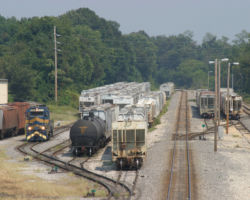
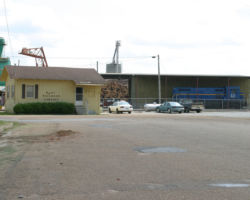
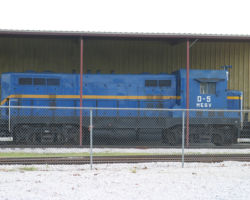
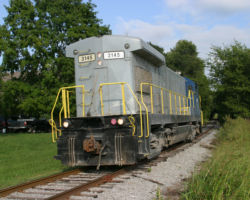
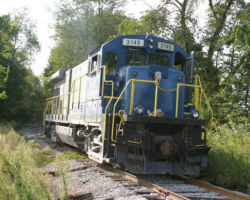
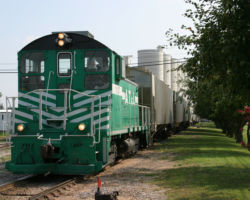
All photographs in this trip report were taken with a Canon EOS 10D using either a Canon 28-105mm USM or a Canon 75-300mm f4-5.3 IS/USM.
This work is copyright 2024 by Nathan D. Holmes, but all text and images are licensed and reusable under a Creative Commons Attribution-NonCommercial-ShareAlike license. Basically you’re welcome to use any of this as long as it’s not for commercial purposes, you credit me as the source, and you share any derivative works under the same license. I’d encourage others to consider similar licenses for their works.
